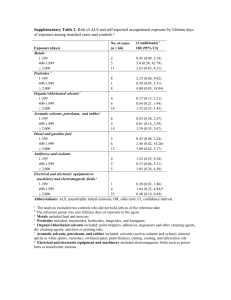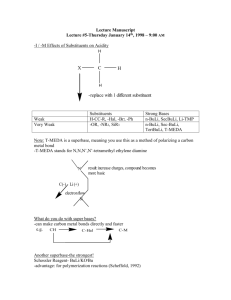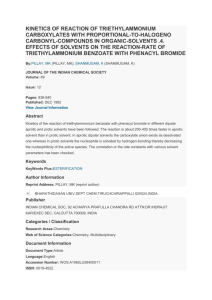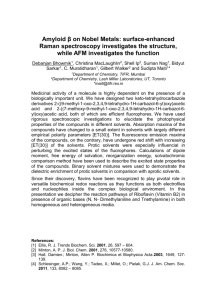CHM 331H Lecture Man..
advertisement
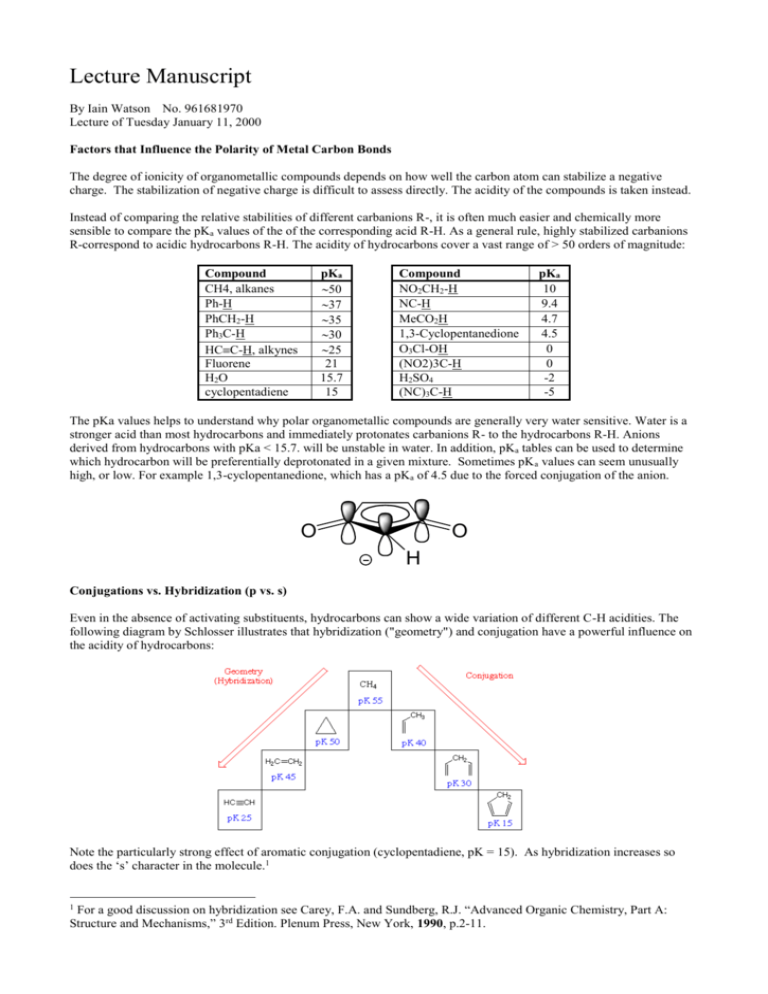
Lecture Manuscript By Iain Watson No. 961681970 Lecture of Tuesday January 11, 2000 Factors that Influence the Polarity of Metal Carbon Bonds The degree of ionicity of organometallic compounds depends on how well the carbon atom can stabilize a negative charge. The stabilization of negative charge is difficult to assess directly. The acidity of the compounds is taken instead. Instead of comparing the relative stabilities of different carbanions R-, it is often much easier and chemically more sensible to compare the pKa values of the of the corresponding acid R-H. As a general rule, highly stabilized carbanions R-correspond to acidic hydrocarbons R-H. The acidity of hydrocarbons cover a vast range of > 50 orders of magnitude: Compound CH4, alkanes Ph-H PhCH2-H Ph3C-H HCC-H, alkynes Fluorene H2O cyclopentadiene pKa 50 37 35 30 25 21 15.7 15 Compound NO2CH2-H NC-H MeCO2H 1,3-Cyclopentanedione O3Cl-OH (NO2)3C-H H2SO4 (NC)3C-H pKa 10 9.4 4.7 4.5 0 0 -2 -5 The pKa values helps to understand why polar organometallic compounds are generally very water sensitive. Water is a stronger acid than most hydrocarbons and immediately protonates carbanions R- to the hydrocarbons R-H. Anions derived from hydrocarbons with pKa < 15.7. will be unstable in water. In addition, pKa tables can be used to determine which hydrocarbon will be preferentially deprotonated in a given mixture. Sometimes pK a values can seem unusually high, or low. For example 1,3-cyclopentanedione, which has a pKa of 4.5 due to the forced conjugation of the anion. O O H Conjugations vs. Hybridization (p vs. s) Even in the absence of activating substituents, hydrocarbons can show a wide variation of different C-H acidities. The following diagram by Schlosser illustrates that hybridization ("geometry") and conjugation have a powerful influence on the acidity of hydrocarbons: Note the particularly strong effect of aromatic conjugation (cyclopentadiene, pK = 15). As hybridization increases so does the ‘s’ character in the molecule.1 For a good discussion on hybridization see Carey, F.A. and Sundberg, R.J. “Advanced Organic Chemistry, Part A: Structure and Mechanisms,” 3rd Edition. Plenum Press, New York, 1990, p.2-11. 1 Solvents The appropriate choice of a solvent is often a key factor for the successful synthesis and use of an organometallic compound. Protic solvents, those containing readily mobile protons, such as those bound to oxygen, nitrogen and sulfur, are rarely compatible with organometallic reactions. Examples of Protic solvents include water (pK a = 15.7), alcohols ROH (pKa ~ 18) and amines R2NH (pKa ~ 22). With aprotic solvents all hydrogen is bound to carbon. Hydrocarbon solvents like pentane, hexane, benzene and toluene are attacked only by the most reactive organometallic compounds. The dielectric constant of a solvent is a function of the permanent dipole of the respective solvent molecule and its polarizability. Polarizability is the ease of distortion of a molecules electron density. The dielectric constant of a solvent is a good indicator of the ability of that solvent to accommodate separation of charge. However, the dielectric constant does not indicate the ability of the solvent molecules to interact with the solute at close range. Direct solute-solvent interactions will depend on the specific structures of the molecules. 2 Below is a table of the dielectric constants of some common solvents.3 Nonpolar Hexane Carbon tetrachloride Dioxane Benzene Diethyl ether Chloroform Tetrahydrofuran Aprotic Solvents Polar 1.9 Pyridine 2.2 Acetone 2.2 Hexamethylphosphoramide 2.3 Nitromethane 4.3 Dimethylformamide 4.8 Acetonitrile 7.6 Dimethyl sulfoxide Protic Solvents 12 21 30 36 37 38 47 Acetic acid Trifluoroacetic acid tert-Butyl alcohol Ammonia Ethanol Methanol Water 6.1 8.6 12.5 (22) 24.5 32.7 78 Ethers are decomposed by a number of organo alkali compounds and are rapidly decomposed by strong bases, halogenating agents or Lewis acids. The choice of solvent in any organometallic reaction is crucial to it’s success or failure. It should also be noted that because of the quantities and frequencies of their use solvents are one of the most common causes of accidents in the laboratory. Especially be aware of the flammability of the hydrocarbons and ethers, the toxisity of benzene, chloroform and carbon tetrachloride and the possibility of peroxide contamination with ethereal solvents. Purification of Solvents Organometallic compounds, especially basic compounds such as Grignard reagents, metal hydrides and organolithiums require the use of carefully dried solvents. There are two steps in the drying of any solvent, pre-drying followed by rigorous drying. The reagents used for rigorous drying are very reactive and must be treated with care, it is also important to avoid dangerous reactions between certain solvents and drying reagents. A great deal of work on the purification of solvents was carried out by D.R. Burfield and R.H. Smithers et al. who ran quantitative studies on the efficiency drying agents in the late 1970s and early 1980s. Below are some comments on important drying agents: 4 Calcium chloride, CaCl2: Effective for pre-drying hydrocarbons and ethers by reversible hydrate formation. Will react with acids, alcohols, amines and some carbonyl compounds. Calcium hydride, CaH2: Dries by irreversible formation of H2 and calcium hydroxide upon contact with water. Will rigorously dry amines, pyridines and HMPA, but is also effective for hydrocarbons, and DMF. Residues should be disposed by slow and careful addition of water. Lithium aluminium hydride, LiAlH4: May be used for drying ethers, but is less effective then sodium-benzophenone. Due to the fact that it may explosively decompose over 100oC most discourage its use. Molecular sieves: Sodium and calcium aluminosilicates with cage-like crystal lattice structures containing pores of various sizes, but most commonly 3Å and 4Å. After activation at 250 oC, under vacuum, for 24 h, molecular sieves are an extremely powerful desiccant. They can be stored in an oven over 100 oC for only a few weeks since they are rapidly hydrolysed in air. Carey, F.A. and Sundberg, R.J. “Advanced Organic Chemistry, Part A: Structure and Mechanisms,” 3 rd Edition. Plenum Press, New York, 1990, p.232-233. 3 Riddick, J.A. and Bunger, W.B. (eds.), Organic Solvents, Vol. II of Techniques of Organic Chemistry, 3rd Edition, Wiley-Interscience, New York, 1970. 4 Casey, M., Lygo, J.L.B., Procter, G. “Advanced Practical Organic Chemistry.” Chapman & Hall, New York, 1990, pp. 28-33 2 Phosphorus pentoxide, P2O5: A rapid and efficient that is limited by high reactivity. Most commonly used for desiccators, but may also be used to dry acetonitrile and hydrocarbons. Phosphorus pentoxide reacts with alcohols, amines, acids and carbonyl compounds and causes the decomposition of HMPA, DMSO and acetone. It is best destroyed by careful addition to ice water followed by neutralisation with base. Never add water to P 2O5, the reaction is very exothermic. Sodium, Na: Sodium is used to dry hydrocarbons and ethers. Its chief disadvantage is that the metal surface rapidly becomes coated with an inert material, therefore, it should not be used unless the solvent is pre-dried. Sodium reacts with benzophenone to give a dark blue colour caused by the ketyl radical. Sodium residues are destroyed by the slow, careful addition of ethanol, stirred well until no lumps of sodium remain. After carefully adding methanol the mixture is allowed to sit for several hours and is then added to a large excess of water. Never use sodium to dry chlorinated solvents, an explosive reaction can occur. Ethereal Solvents Ethereal solvents (Et2O, THF, DME and dioxan) can contain substantial amounts of peroxides formed from exposure to the air. Peroxides can cause serious explosions and must be removed before distillation. Test for peroxides:5 add 1 mL the solvent to 1 mL of a 10% solution of sodium iodide in acetic acid. A yellow colour indicates the presence of low concentrations of peroxides while a brown colour indicates high concentrations. Low concentrations of peroxides can be removed be a variety of methods.6 A common method is to shake the solvent with concentrated aqueous ferrous sulfate. Ethers are usually pre-dried over calcium chloride or sodium wire, and rigorously dried over sodium-benzophenone. Careful preliminary drying is important because ethereal solvents can all dissolve substantial quantities of water. Solvent Diethyl Ether Et2O Tetrahydrofuran THF 1,4-Dioxane Formula C4H10O bp 34oC mp -116oC C4H8O 66oC -108oC C4H8O2 101oC 12oC 1,2-Dimethoxyethane DME, glyme 2-Methoxyethylether diglyme 1,2-bis(2-Methoxyethoxy) ethane, triglyme C4H10O2 85oC -58oC C6H14O3 162oC -64oC C8H18O4 216oC -45oC Cost 98+% ACS reagent 4L $77.70 99+% ACS reagent 4L $97.40 99+% ACS reagent 4L $141.50 99+% 4L $220.40 99% 4L $162.40 99% 3 kg $173.60 Toxicity low high, carcinogen high, carcinogen high high high The boiling point of the ethers is particularly important. To prevent decomposition of the often thermolabile organometallic compound, the preferred way of isolation is to evaporate the solvent at room temperature under vacuum. The solvent is collected in a trap cooled with liquid nitrogen, a procedure called cryogenic distillation. Diethylether, Dioxane, THF and Et3N are easily evaporated in vacuum most frequently used. The other solvents have high boiling points (difficult to remove) and are also quite expensive. They cannot be distilled over LiAlH 4, because their boiling points exceeds the decomposition temperature of LiAlH 4. As a result, these solvents are only use if high boiling points are desirable (reflux temperature) or if their solubilizing power is needed (glyme & derivatives). Ethers can coordinate to organometallic compounds (oxygen lone pairs). This helps to accelerate many organometallic reactions. For the formation of Grignard reagents RMgHal, the choice of ethers is essential. Decomposition of Ethers: Halogenation Although ethers are chemically fairly robust, they can be decomposed by a small number of reagents: Bases Lewis acids Halogenation agents Chlorine and bromine reacts with ethers to form the highly carcinogenic alpha-halo-ethers: 5 6 Casey, M., Lygo, J.L.B., Procter, G. “Advanced Practical Organic Chemistry.” Chapman & Hall, New York, 1990, p.36 Burfield, D.R. J. Org. Chem., 1982, 47, 3821. The following transition metal chlorides are strongly oxidizing and can lead to the chlorination of ethers: V VCl4 (NbCl5)2 VI VII MoCl5 WCl6 > WCl5 ReCl5 Amine Solvents The importance of these solvents has decreased since the 1940s. Many of these solvents, such as TEA, py and liquid ammonia, are bases, which can be important in applications. The use of liquid ammonia as a solvent has gradually been replaced, however there are still some important uses such as reactions involving lithium amide or sodium amide as bases and dissolving metal type reductions (the Birch reaction) 7 CO2- CO2- Li, NH3 EtOH Birch Reduction with an electron withrawing group gives the 1,4-dihydro derivative OMe OMe Li, NH3 H+ EtOH H2O O Synthesis of cyclohexenones via reduction of methoxybenzenes followed by hydrolysis Pyridine and triethylamine can both be dried by distilling from CaH2 into 4 A molecular sieves. Solvent Triethylamine TEA, Et3N Pyridine py Liquid ammonia NH3 Formula C6H15N bp 89oC mp -115oC C5H5N 115oC -42oC NH3 -33oC -78oC Cost 99.5% 2 L $77.00 99+% ACS reagent 4L $192.70 99.99+% in lecture bottle 170g $373.40 Toxicity high high, carcinogen Ammonia gas is condensed directly into a reaction vessel via a dry-ice condenser (shown below) Carey, F.A. and Sundberg, R.J. “Advanced Organic Chemistry, Part B: Reactions and Synthesis,” 3 rd Edition. Plenum Press, New York, 1990, p.256-257. 7 First ammonia is allowed to flush the system before an acetone/CO2 bath is added into the condenser. The ammonia will condense and when the reaction vessel has the required amount the flow is shut off. Ammonia can be dried by placing sodium pieces in the flask until the dark blue colour persists, followed by distillation of the ammonia into a reaction vessel. Hydrocarbon Solvents Hydrocarbon solvents such as hexanes, pentane, benzene and toluene are very non-polar solvents which are regularly used in organometallic chemistry. Due to their non-polar nature these solvents are relatively easy to dry. Hexanes is a mixture of hexane isomers and usually also contains some methylcyclopentane. Hexanes and pentane can be dried by simply distilling into 4 A molecular sieves. Benzene and toluene are first pre-dried with CaH2 (3% w/v for 6 h) then distilled into 4 A molecular sieves. This should reduce the water content to < 1ppm. Solvent Hexanes Benzene Toluene PhMe Pentane Formula mixture of hexane isomers plus methylcyclopentane C6H6 bp 68-70oC mp - Cost 98.5+% ACS reagent 4L $96.40 Toxicity high 80oC 5.5oC C7H9 110.6oC -93oC high, carcinogen high C5H12 35-36oC -130oC 99% ACS reagent 4L $96.40 99.5+% ACS reagent 4L $60.70 98% 4 L $67.20 high

